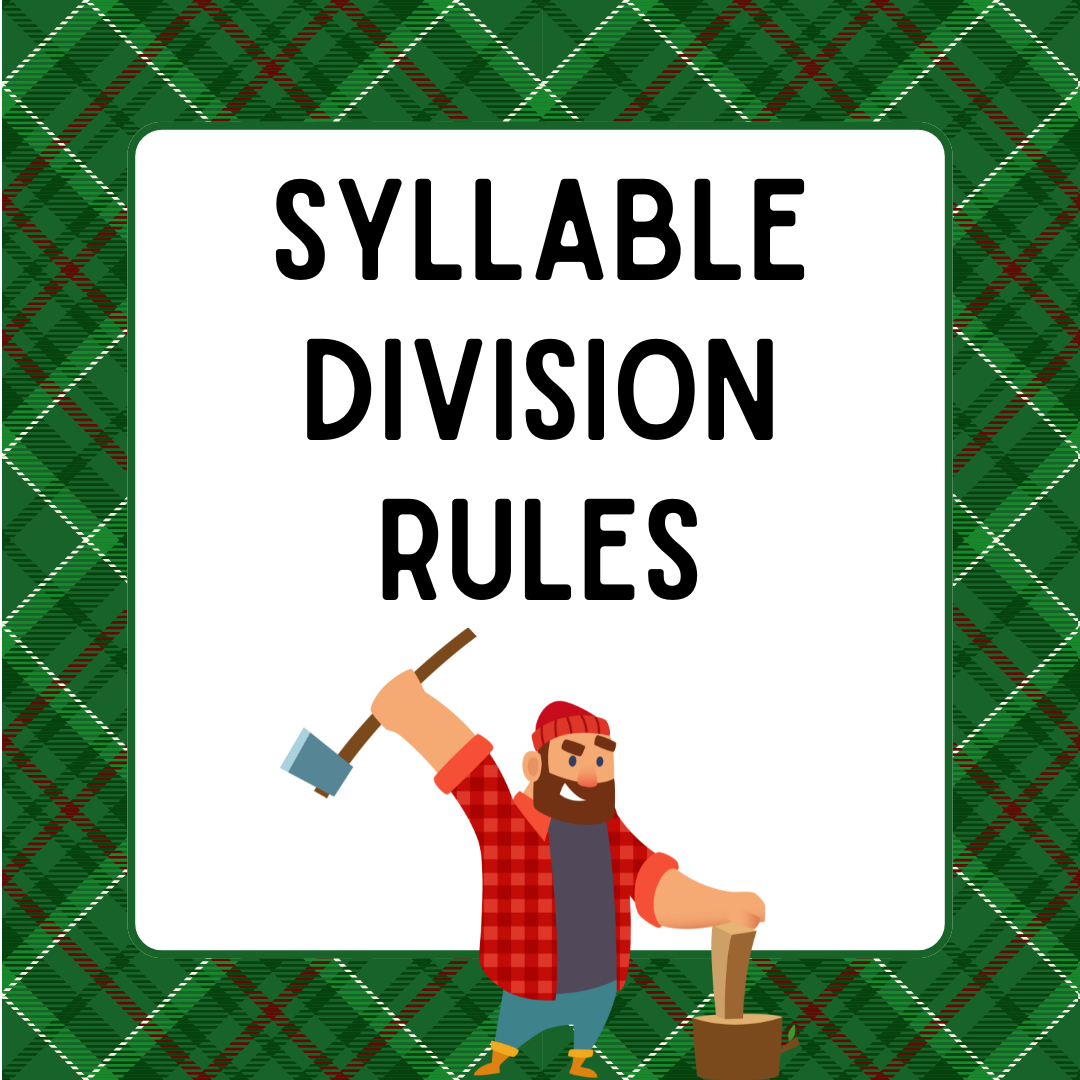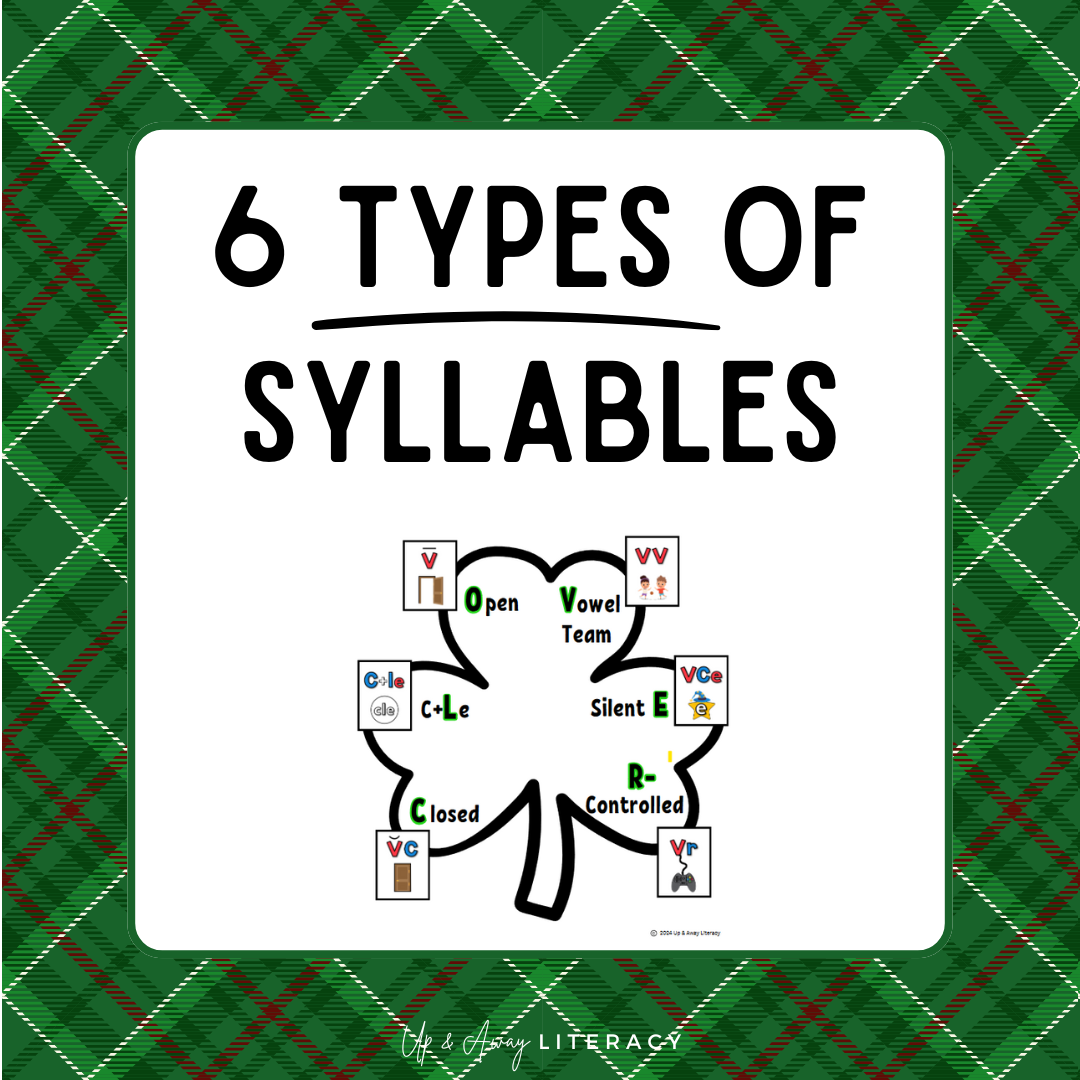
Syllable Division Series: Part 1
When it comes to reading and spelling, one of the most effective tools a learner can have in their toolkit is a solid understanding of how to divide multisyllabic words into smaller syllables. This understanding not only helps with decoding unfamiliar words, but also helps with spelling these longer words. For students, knowing how to break words down into syllables can be empowering and can make those long, challenging words seem a little less daunting!
Before we jump into syllable division, let's cover some basics first...
What Are Syllables?
A syllable is a single, unbroken sound unit within a word. Every syllable contains a vowel sound and is made with one push of breath. For example, the word basket has two syllables: bas and ket. In the English language, there are 6 different types of syllables that make up words.
What Are the 6 Types of Syllables?
An easy way to remember all 6 syllable types is to think of the word CLOVER. Each letter stands for one of the syllable types. Below, we'll explore each one! (Get the free poster HERE)
1. Closed Syllable- A closed syllable has a single vowel with at least one consonant after it. The vowel is closed in so it makes it's short sound.
Examples of closed, 1-syllable words: cat, big, tent, stump, shrug
Examples of multisyllabic words containing closed syllables: bas|ket, muf|fin, ban|dit, con|tact

2. Consonant-le Syllable- A consonant +le syllable has a consonant followed by the letters <le>. This syllable type is only found in multisyllabic words.
Examples of multisyllabic words containing the consonant-le syllable: ta|ble, lit|tle, can|dle, ti|tle

3. Open Syllable- An open syllable has a single vowel with no consonants after it. The vowel is open so it makes it's long vowel sound.
Examples of open, 1-syllable words: go, she, hi, me, try
Examples of multisyllabic words containing closed syllables: a|ble, o|pen, ho|tel, ro|bot, mu|sic

4. Vowel Team Syllable- A vowel team syllable is a syllable with 2 or more letters that work together to make one vowel sound.
Examples of 1-syllable vowel team words: boat, rain, light, throw, shout
Examples of multisyllabic words containing closed syllables: play|room, main|tain, ea|gle, nee|dle
5. Silent E Syllable- A silent E syllable has a vowel followed by a consonant and then a silent E. The vowel makes it's long vowel sound.
Examples of 1-syllable words with silent E: cake, time, slide, bone, flute
Examples of multisyllabic words containing a silent E syllable: cup|cake, in|side, par|take, lime|ade
6. R-controlled Vowel Syllable- An r-controlled vowel syllable has a vowel followed by the letter <r>. The vowel+r make a special sound together.
Examples of 1-syllable, r-controlled vowel words: bird, farm, turn, short, her
Examples of multisyllabic words containing an r-controlled vowel: birth|day, cor|ner, per|fect
Now that we've covered the 6 syllable types, let's discuss one more thing before we talk about the syllabic division rules...
How Can You Tell If a Word is Multisyllabic?
To tell if a word is multisyllabic, look for vowels spread apart in a word. Since we know that every syllable has to have a vowel, when we see multiple vowels spread out in a word, that is a clue that it is multisyllabic.
When we notice a word has more than one syllable, we should do the following:
1- Find the first 2 vowels in the word and mark them with a V
2- Mark the consonants in between with a C
3- Determine the syllable division pattern and divide (see below for the patterns and rules!)
Syllable Division Rules

Finally! We've made it to the most important part. Once you know the word is multisyllabic, you've marked the first 2 vowels, and labeled the consonants in between, you're going to determine the syllable division pattern. Here are the 5 most common division patterns and rules:
1. VC/CV (Vowel-Consonant/Consonant-Vowel)

This pattern and rule is probably the easiest because it's always the same. If the word has a VCCV pattern, the rule is to split between the two consonants.
-
Examples: nap/kin, but\ter, han|dle, bas|ket
2. VCCCV

The VCCCV pattern and rule is a little bit more complicated. When you see the VCCCV pattern, you first have to look at the 3 consonants in beween and find the digraph or blend that needs to stick together. Then, divide between the two consonants that don't.
-
Examples: pump|kin, dish|rag, in|clude, mon|ster
3. VCV

The VCV pattern and rule might be the trickiest because it takes a bit of trial and error. When a word has this pattern, first try to split before the consonant. This will leave the 1st syllable as an open syllable with a long vowel sound. If that doesn't make a word, split after the consonant instead. This will make the 1st syllable a closed syllable with a short vowel sound. You may have to try it both ways to find which way makes sense!
-
Examples: ti/ger (V/CV) vs. lem/on (VC/V)
4. C+le (Consonant + le)

When a multisyllabic word has the consonant-le pattern, divide by starting at the <e> and counting back 3 letters. Then, split. We like to teach our students this fun chant: "When there's a consonant-le, then you count back three... 1, 2, 3, split!"
-
Examples: ta/ble, bub/ble
5. VV (Vowel/Vowel)

This is probably the least common syllable division pattern, but still important to know! If a word has the VV pattern and you decide that the two vowels aren't working together as a vowel team (to make one vowel sound), split between the two vowels. This will make the first syllable an open syllable and it will make it's long sound.
-
Examples: ne/on, po/et, flu|id
Next Up...
In next week's blog post, we'll be continuing this series with Part 2 which will be all about spelling multisyllabic words. Be sure to stick around to learn how to teach your students to break apart and spell these longer words!
Multisyllabic Resources That Are Done-For-You!
Digital SoR Phonics Lessons for Syllable Division Rules- In these digital phonics lessons, syllable division rules are taught with a fun, woodcutter theme! Woodcutter Jack helps kids understand how to *chop* up words into smaller syllables using these syllable division strategies! Included are 10 digital lessons (2 for each rule), 5 decodable word lists, 5 encoding guides, and 5 decodable readers!
Big Words Bootcamp: A Multisyllabic Mission to Decoding Large Words- Send your students to Big Words Bootcamp where they'll learn how to attack multisyllabic words! Included are an invitation for students, slideshow teaching the ASK strategy for dividing multisyllabic words, student practice pages, posters, bookmarks, and a certificate of completion.
Syllable CHOP! {Multisyllabic Word Practice by Phonics Feature}- Are you wanting your students to practice decoding multisyllabic words that include specific phonics features? If so, this is for you! Students will be able to practice syllable division with 46 different phonics patterns. This is a great way to weave multisyllabic words into your phonics instruction! Included are directions for use, student syllable division mats, 5 syllable division posters, and 46 sets of multisyllabic word cards (organized by phonics skill).
Stay in-the-know!
New tips, courses, and resources delivered straight to your inbox. Sign up for our email list below so you don't miss a thing!




